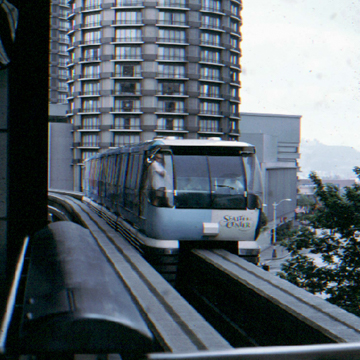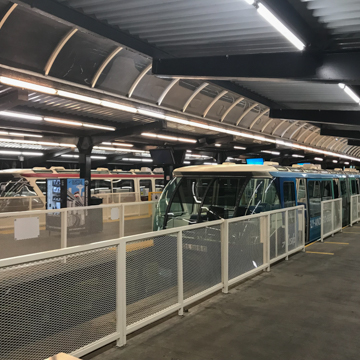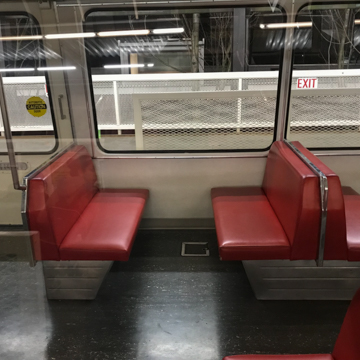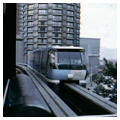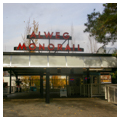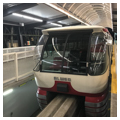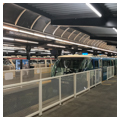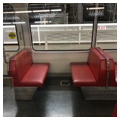You are here
Seattle Center Monorail
Gliding effortlessly between the Seattle Center and the Westlake Center in downtown Seattle, the sleek Seattle Center Monorail, built originally for the 1962 world’s fair, was among the best representatives of the exposition’s futuristic, technologically driven, space-age image. Originally named after the company that founded and built it, Alweg, the 1.2-mile-long monorail was also the first full-scale commercial monorail constructed in the United States. It remains one of the only urban monorails still in existence.
The $3.5 million monorail emerged specifically as a response to projected traffic and parking concerns during the Century 21 Exposition. Anticipating thousands of visitors daily, fair planners decided to use a futuristic mass transit system to highlight the theme of the fair, to serve as an attraction, and to provide convenient access. It was not the first time that high-speed public transportation had been planned to move people to the general site: in 1911, a subway/monorail system had been proposed by Virgil Bogue in the unrealized 1911 Bogue Plan for what was then envisioned as a new civic center for Seattle.
The monorail was designed by the German-based Alweg Company, which had been founded by Axel Lennert Wenner-Gren in Cologne, Germany, in 1952. Wenner-Gren developed a straddle-beam concept for a monorail, and began marketing it for an alternative mass transit option by the late 1950s. In 1959, Walt Disney commissioned a 5/8th-scale Alweg monorail as an amusement ride for the new “Tomorrowland” section of Disneyland in Anaheim and, by 1961, the track was extended 2.5 miles to the Disneyland Hotel. On April 2, 1961, the day that Alweg’s American subsidiary, Wegematic Corporation, began construction of a similar design for Seattle, Senator Warren G. Magnuson intoned the theme of the fair at the monorail’s groundbreaking: “The world of tomorrow is at our doorstep today.”
The Seattle Center Monorail consists of two four-car trains that traverse the 1.2-mile elevated track of pre-stressed, precast concrete “guide-way beams” in 95 seconds. Each train was designed to ride upon 64 rubber pneumatic tires, with 16 load-carrying tires on top of the beams and 48 guide tires gripping the sides. This was an innovative system called a “bogey” design, which allowed the guide tires to “steer” the bogey through the curves of the beamway while providing independent suspension for superior ride quality. Trains were powered by a 700-volt DC current through contact rails at the inside of the beam.
A significant technical design feature of the Seattle monorail is the low weight and high-load carrying capacity of the train cars. Passenger load represents 75 percent of the empty weight of the train, a ratio that is an important measure of the design’s structural efficiency. This is due, in part, to the hollow, lightweight guide-way beams. However, the supporting pylons’ strength is based on mass rather than high-strength materials, using typical low-strength 3,750 psi concrete and 10,000 ksi steel reinforcing bars.
The terminals at the Westlake Center and the Seattle Center, designed by Los Angeles–based Adrian Wilson and Associates, were placed at the level of the track, accessed by inclined moving sidewalks and protected by barrel vault–shaped plastic roofs. As with the train cars, the terminal designs were also intended to be futuristic.
Opening day for the Seattle Center Monorail was March 24, 1962, one month before the opening of the fair. The monorail was an immediate success and, during the six months of the fair, carried more than eight million riders, which helped account for the cost of construction. Alterations to the monorail in later decades included the demolition of the Westlake Terminal in 1986, its incorporation into the Westlake Mall by 1988, and the replacement of the inclined, moving sidewalk with a concrete ramp at the Seattle Center Terminal. In 1997 and 2002, plans were made to extend the monorail 14 miles in either direction from West Seattle to Ballard, but after some steps were taken to secure land, the cost of the project made it unfeasible.
Yet even with the extension of Seattle’s light rail system and the monorail’s operation under the auspices of several different ownership entities—public and private—in its 60-year history, the Seattle Monorail continues to serve a steady number of passengers. In the early twenty-first century, the monorail—now entering and exiting the Seattle Center through a portion of Frank Gehry’s Museum of Popular Culture—was averaging about two million passengers per year.
Writing Credits
If SAH Archipedia has been useful to you, please consider supporting it.
SAH Archipedia tells the story of the United States through its buildings, landscapes, and cities. This freely available resource empowers the public with authoritative knowledge that deepens their understanding and appreciation of the built environment. But the Society of Architectural Historians, which created SAH Archipedia with University of Virginia Press, needs your support to maintain the high-caliber research, writing, photography, cartography, editing, design, and programming that make SAH Archipedia a trusted online resource available to all who value the history of place, heritage tourism, and learning.














